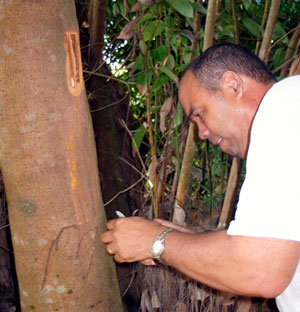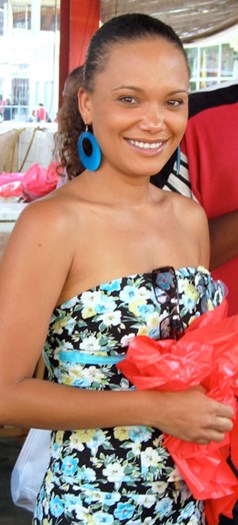MAHÉ ISLAND, SEYCHELLES – Joseph, the jovial cab driver, insisted we stop along the Coast Road, this island’s main highway, so he could cut some cinnamon bark for us to take home.
“It will be your souvenir of our island,” said Joseph, a handsome man with a moon face which always seemed to be wearing a smile.
The middle aged Joseph disappeared into some dense forest and a few minutes later reappeared holding the pungent cinnamon bark, which accounts for one of the Seychelles’ chief exports.
“We ship most of the cinnamon abroad but we keep some to make our cinnamon liquor,” said Joseph about this country’s potent national drink.
“We’ll buy some (cinnamon liquor) when we reach Victoria.”
We pushed along the Coast Road in the direction of the nation’s capital and along the way marveled at all this relatively unknown paradise has to offer. And paradise is the correct word to describe the Seychelles, made up of hundreds of tiny islands, one of which is Praslin, the country’s second largest island and where you’ll find the Vallee de Mai, a UNESCO World Heritage Site that early explorers described as the “Garden of Eden.”


Left: Joseph cuts some fresh cinnamon. Right: A local beauty at the market.
Victoria, named after the British Queen, was relatively quite the day Joseph guided his taxi down its handsome main street made up of local shops selling island spices on one side and a handful of souvenir and craft shops on the other.
“Take your time and explore the city,” Joseph encouraged us. “The market is just behind the main street and it’s where you can buy spices and fresh fish. It’s quite safe – no one will bother you there.”
Joseph headed in the direction of some fellow cabbies and we began to wander what’s known as the smallest national capital city in the world – population 3,000. The tallest structure here is the city’s main church and beautiful iron clock sits in the main roundabout. Queen Victoria is remembered with a small statue off the main street which could easily fit on most mantles.
Just outside the city sits a small cemetery reputed to be the resting place of exiled king of France - King Louis XVII – who is believed to be buried under a gravestone bearing the name of Pierre Louis Poiret. The boy king was the son of King Louis XVI and Marie Antoinette and was reportedly smuggled out of France after his parents were executed during the French Revolution.
The market offered us a glimpse into local life with vendors gutting fresh fish, florists arranging local flowers and spicy scents filling the air. On a side street of this Indian Ocean island that sits off Kenya neatly dressed school children stopped beside graffiti covered walls to have their photographs taken by the stranger with the digital camera.
There's even a botanical garden in the centre of Victoria, which seemed redundant since all of Mahe is a living botanical garden.
The Seychelles were populated by slaves who were rounded up, first by the French and then the British, and brought to this Indian Ocean archipelago before being shipped to the colonies.
"Before my ancestors arrived, no one lived on Mahe," Selby, a local man we met w2hile enjoying some cinnamon liquor, informed us. "No one lived on any of the (115) islands that make up my country before the slave traders brought us here.
"When slavery was abolished by the French and British (the Brits ruled the Seychelles after voting the French off around 1794) they just left the slaves behind and we became Seychellois."
Mahe, even though it's only 27 km long and just seven km wide, is the largest of the Seychelles islands, sandwiched between Africa and Asia. Europeans, South Africans and Asians favor it as their holiday retreat of choice.
"There is a very vibrant fish industry on this island," Selby told us.
The waters off the Seychelles are rich with sea life. Beyond the treasured coral reef that acts like a natural barrier around Mahe, the islands' fishermen reel in giant tuna, the lifeblood of the country's economy. The Indian Ocean also serves up smaller varieties that the locals dine on, but surprisingly, according to Selby, there are few sharks swimming in the warm waters now teeming with divers and smokeless.
"The sharks are afraid of us because we eat them," said the ever jovial Selby. "There are little sharks in the waters and they make a very nice shark chutney - very good."
Shark chutney is not the only island delicacy. According to Selby, the wide-wing fruit bats that are silhouetted by the night sky "make a nice curry." Selby spoke perfect English, as well as French and Creole.
"Everyone here speaks three languages. Our Creole (the Seychellois actually spell it k-r-e-o-l ) is the language of the slaves - a combination of French and English."
It's unlike the Creole spoken in other parts of the world, which causes some confusion when slave descendants from as far away as Louisiana come to the Seychelles to celebrate cultural festivals from time to time.
"No sir, I can't understand what they are saying when they come here," said Selby with a deep laugh that brightened his already cheerful face. "So we just sing and dance the sega (a folk dance once performed by his slave ancestors)."
The French the Seychellois speak is also different. Here, bonjour (hello) becomes bonzour and s'il vous plait (please) is pronounced sivouple.
Portuguese explorer Vasco da Gama is believed to have passed the Seychelles in 1503 and another Portuguese navigator, Fernao Soares recorded the islands in 1506. France claimed the islands in 1742 for their valuable spices.
Cinnamon trees are still plentiful on these islands and high in the hills, tea is grown. (I highly recommend the lemon grass blend). Mahe's landscape is dominated by granite mountains, lush tropical forests laden with banana trees and delicate flowers and the pencil-straight sang dragon tree, which creates natural avenues within the deep brush where people can walk and be serenaded by the many rare song birds that call Seychelles home.
The drive along the Coast Road is highlighted by romantic sea vistas featuring small coves and some strange looking little islands. The constant tidal erosion along the coastline has created mushroom-shaped islets and Praslin has lots of them. To lend more credence to the “Garden of Eden” label, the locals pointed out that it’s been many years since they’ve had a typhoon or hurricane, However, the Seychelles was struck by the massive tsunami a few years ago that claimed over 300,000 lives throughout Asia. Fortunately the loss of life and damage were minimal here.
Mahe is also the land of giant sea turtles, who regularly come on shore to lay their eggs. Largest among them is the endangered green turtle, of which islanders and resorts like Banyan Tree (where we lived for a few days in the lap of luxury) are very protective.
On our way back to the 5-star Banyan Tree property – worth the 10 hour flight from Paris all on its own – we passed natural floral arrangements featuring the flamboyant delonit regia tree and its dramatic red blossoms and lots and lots of orchids - the rare Mokara Madame Panes variety was my favorite. Yellow, green and orange coconuts also caught our eye.
"The yellow and orange coconuts are only good for their meat," said Joseph. "Only the green one produces milk - but the orange and yellow are much prettier, non?"
Everything is pretty on the Seychelles – but what else would you expect in the home of the “Garden of Eden.”
Information
For information on the Banyan Tree Seychelles Resort, located in Takamaka, on the beautiful secluded southwest coast of Mahe, go to
banyantree.com